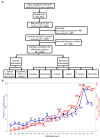Research hotspots and trends on spinal cord stimulation for pain treatment: a two-decade bibliometric analysis
- PMID: 37304039
- PMCID: PMC10248081
- DOI: 10.3389/fnins.2023.1158712
Research hotspots and trends on spinal cord stimulation for pain treatment: a two-decade bibliometric analysis
Abstract
Background: Chronic pain poses a significant social burden. Spinal cord stimulation (SCS) is considered to be the most promising treatment for refractory pain. The aim of this study was to summarize the current research hotspots on SCS for pain treatment during the past two decades and to predict the future research trends by bibliometric analysis.
Methods: The literature over the last two decades (2002-2022) which was related to SCS in pain treatment was obtained from the Web of Science Core Collection. Bibliometric analyses were conducted based on the following aspects: (1) Annual publication and citation trends; (2) Annual publication changes of different publication types; (3) Publications and citations/co-citations of different country/institution/journal/author; (4) Citations/co-citation and citation burst analysis of different literature; and (5) Co-occurrence, cluster, thematic map, trend topics, and citation burst analysis of different keywords. (6) Comparison between the United States and Europe. All analyses were performed on CiteSpace, VOSviewer, and R bibliometrix package.
Results: A total of 1,392 articles were included in this study, with an increasing number of publications and citations year by year. The most highly published type of literature was clinical trial. United States was the country with the most publications and citations; Johns Hopkins University was the institution with the most publications; NEUROMODULATION published the most papers; the most published author was Linderoth B; and the most cited paper was published in the PAIN by Kumar K in 2007. The most frequently occurring keywords were "spinal cord stimulation," "neuropathic pain," and "chronic pain," etc.
Conclusion: The positive effect of SCS on pain treatment has continued to arouse the enthusiasm of researchers in this field. Future research should focus on the development of new technologies, innovative applications, and clinical trials for SCS. This study might facilitate researchers to comprehensively understand the overall perspective, research hotspots, and future development trends in this field, as well as seek collaboration with other researchers.
Keywords: CiteSpace; VOSviewer; bibliometric; bibliometrix; pain treatment; research trends; spinal cord stimulation.
Copyright © 2023 Yang, Zhong, Fan, Zhu, Xu, Liao, Fan, Liao and He.
Conflict of interest statement
The authors declare that the research was conducted in the absence of any commercial or financial relationships that could be construed as a potential conflict of interest.
Figures









Similar articles
-
Global Trends and Hotspots on Microglia Associated with Pain from 2002 to 2022: A Bibliometric Analysis.J Pain Res. 2023 Aug 15;16:2817-2834. doi: 10.2147/JPR.S413028. eCollection 2023. J Pain Res. 2023. PMID: 37600079 Free PMC article.
-
Research Hotspots and Trends of Peripheral Nerve Injuries Based on Web of Science From 2017 to 2021: A Bibliometric Analysis.Front Neurol. 2022 May 20;13:872261. doi: 10.3389/fneur.2022.872261. eCollection 2022. Front Neurol. 2022. PMID: 35669875 Free PMC article.
-
A bibliometric analysis of the research hotspots and frontiers related to cell death in spinal cord injury.Front Neurol. 2024 Jan 5;14:1280908. doi: 10.3389/fneur.2023.1280908. eCollection 2023. Front Neurol. 2024. PMID: 38249747 Free PMC article.
-
Bibliometric and visualized analysis of ocular drug delivery from 2001 to 2020.J Control Release. 2022 May;345:625-645. doi: 10.1016/j.jconrel.2022.03.031. Epub 2022 Mar 20. J Control Release. 2022. PMID: 35321827 Review.
-
Recent trends in acupuncture for chronic pain: A bibliometric analysis and review of the literature.Complement Ther Med. 2023 Mar;72:102915. doi: 10.1016/j.ctim.2023.102915. Epub 2023 Jan 4. Complement Ther Med. 2023. PMID: 36610367 Review.
Cited by
-
Intra-Examiner Reliability and Validity of Sagittal Cervical Spine Mensuration Methods Using Deep Convolutional Neural Networks.J Clin Med. 2024 Apr 27;13(9):2573. doi: 10.3390/jcm13092573. J Clin Med. 2024. PMID: 38731102 Free PMC article.
References
-
- Amirdelfan K., Yu C., Doust M. W., Gliner B. E., Morgan D. M., Kapural L., et al. . (2018). Long-term quality of life improvement for chronic intractable back and leg pain patients using spinal cord stimulation: 12-month results from the SENZA-RCT. Qual. Life Res. 27, 2035–2044. doi: 10.1007/s11136-018-1890-8, PMID: - DOI - PubMed
-
- Billot M., Naiditch N., Brandet C., Lorgeoux B., Baron S., Ounajim A., et al. . (2020). Comparison of conventional, burst and high-frequency spinal cord stimulation on pain relief in refractory failed back surgery syndrome patients: study protocol for a prospective randomized double-blinded cross-over trial (MULTIWAVE study). Trials 21:696. doi: 10.1186/s13063-020-04587-6, PMID: - DOI - PMC - PubMed
-
- Breivik H., Eisenberg E., O’Brien T. (2013). The individual and societal burden of chronic pain in Europe: the case for strategic prioritisation and action to improve knowledge and availability of appropriate care. BMC Public Health 13:1229. doi: 10.1186/1471-2458-13-1229, PMID: - DOI - PMC - PubMed
LinkOut - more resources
Full Text Sources
Miscellaneous

